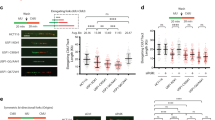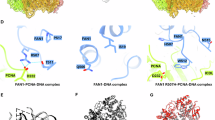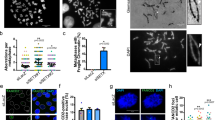Abstract
DNA replication and repair are critical processes for all living organisms to ensure faithful duplication and transmission of genetic information. Flap endonuclease 1 (Fen1), a structure-specific nuclease, plays an important role in multiple DNA metabolic pathways and maintenance of genome stability. Human FEN1 mutations that impair its exonuclease activity have been linked to cancer development. FEN1 interacts with multiple proteins, including proliferation cell nuclear antigen (PCNA), to form various functional complexes. Interactions with these proteins are considered to be the key molecular mechanisms mediating FEN1's key biological functions. The current challenge is to experimentally demonstrate the biological consequence of a specific interaction without compromising other functions of a desired protein. To address this issue, we established a mutant mouse model harboring a FEN1 point mutation (F343A/F344A, FFAA), which specifically abolishes the FEN1/PCNA interaction. We show that the FFAA mutation causes defects in RNA primer removal and long-patch base excision repair, even in the heterozygous state, resulting in numerous DNA breaks. These breaks activate the G2/M checkpoint protein, Chk1, and induce near-tetraploid aneuploidy, commonly observed in human cancer, consequently elevating the transformation frequency. Consistent with this, inhibition of aneuploidy formation by a Chk1 inhibitor significantly suppressed the cellular transformation. WT/FFAA FEN1 mutant mice develop aneuploidy-associated cancer at a high frequency. Thus, this study establishes an exemplary case for investigating the biological significance of protein-protein interactions by knock-in of a point mutation rather than knock-out of a whole gene.
Similar content being viewed by others
Log in or create a free account to read this content
Gain free access to this article, as well as selected content from this journal and more on nature.com
or
References
Bambara RA, Murante RS, Henricksen LA . Enzymes and reactions at the eukaryotic DNA replication fork. J Biol Chem 1997; 272:4647–4650.
Lieber MR . The FEN-1 family of structure-specific nucleases in eukaryotic DNA replication, recombination and repair. Bioessays 1997; 19:233–240.
Liu Y, Kao HI, Bambara RA . Flap endonuclease 1: a central component of DNA metabolism. Annu Rev Biochem 2004; 73:589–615.
Parrish JZ, Yang C, Shen B, Xue D . CRN-1, a Caenorhabditis elegans FEN-1 homologue, cooperates with CPS-6/EndoG to promote apoptotic DNA degradation. EMBO J 2003; 22:3451–3460.
Singh P, Zheng L, Chavez V, Qiu J, Shen B . Concerted action of exonuclease and Gap-dependent endonuclease activities of FEN-1 contributes to the resolution of triplet repeat sequences (CTG)n- and (GAA)n-derived secondary structures formed during maturation of Okazaki fragments. J Biol Chem 2007; 282:3465–3477.
Zheng L, Dai H, Zhou M, et al. Fen1 mutations result in autoimmunity, chronic inflammation and cancers. Nat Med 2007; 13:812–819.
Zheng L, Zhou M, Chai Q, et al. Novel function of the flap endonuclease 1 complex in processing stalled DNA replication forks. EMBO Rep 2005; 6:83–89.
Johnson RE, Kovvali GK, Prakash L, Prakash S . Requirement of the yeast RTH1 5′ to 3′ exonuclease for the stability of simple repetitive DNA. Science 1995; 269:238–240.
Reagan MS, Pittenger C, Siede W, Friedberg EC . Characterization of a mutant strain of Saccharomyces cerevisiae with a deletion of the RAD27 gene, a structural homolog of the RAD2 nucleotide excision repair gene. J Bacteriol 1995; 177:364–371.
Tishkoff DX, Filosi N, Gaida GM, Kolodner RD . A novel mutation avoidance mechanism dependent on S. cerevisiae RAD27 is distinct from DNA mismatch repair. Cell 1997; 88:253–263.
Kucherlapati M, Yang K, Kuraguchi M, et al. Haploinsufficiency of Flap endonuclease (Fen1) leads to rapid tumor progression. Proc Natl Acad Sci USA 2002; 99:9924–9929.
Larsen E, Gran C, Saether BE, Seeberg E, Klungland A . Proliferation failure and gamma radiation sensitivity of Fen1 null mutant mice at the blastocyst stage. Mol Cell Biol 2003; 23:5346–5353.
Biswas EE, Zhu FX, Biswas SB . Stimulation of RTH1 nuclease of the yeast Saccharomyces cerevisiae by replication protein A. Biochemistry 1997; 36:5955–5962.
Chai Q, Zheng L, Zhou M, Turchi JJ, Shen B . Interaction and stimulation of human FEN-1 nuclease activities by heterogeneous nuclear ribonucleoprotein A1 in alpha-segment processing during Okazaki fragment maturation. Biochemistry 2003; 42:15045–15052.
Li X, Li J, Harrington J, Lieber MR, Burgers PM . Lagging strand DNA synthesis at the eukaryotic replication fork involves binding and stimulation of FEN-1 by proliferating cell nuclear antigen. J Biol Chem 1995; 270:22109–22112.
Siegal G, Turchi JJ, Myers TW, Bambara RA . A 5′ to 3′ exonuclease functionally interacts with calf DNA polymerase epsilon. Proc Natl Acad Sci USA 1992; 89:9377–9381.
Zhu FX, Biswas EE, Biswas SB . Purification and characterization of the DNA polymerase alpha associated exonuclease: the RTH1 gene product. Biochemistry 1997; 36:5947–5954.
Brosh RM Jr, von Kobbe C, Sommers JA, et al. Werner syndrome protein interacts with human flap endonuclease 1 and stimulates its cleavage activity. EMBO J 2001; 20:5791–5801.
Dianova, II, Bohr VA, Dianov GL . Interaction of human AP endonuclease 1 with flap endonuclease 1 and proliferating cell nuclear antigen involved in long-patch base excision repair. Biochemistry 2001; 40:12639–12644.
Wang W, Brandt P, Rossi ML, et al. The human Rad9-Rad1-Hus1 checkpoint complex stimulates flap endonuclease 1. Proc Natl Acad Sci USA 2004; 101:16762–16767.
Saharia A, Guittat L, Crocker S, et al. Flap endonuclease 1 contributes to telomere stability. Curr Biol 2008; 18:496–500.
Sampathi S, Bhusari A, Shen B, Chai W . Human flap endonuclease I is in complex with telomerase and is required for telomerase-mediated telomere maintenance. J Biol Chem 2009; 284:3682–3690.
Farina A, Shin JH, Kim DH, et al. Studies with the human cohesin establishment factor, ChlR1. Association of ChlR1 with Ctf18-RFC and Fen1. J Biol Chem 2008; 283:20925–20936.
Zheng L, Dai H, Qiu J, Huang Q, Shen B . Disruption of the FEN-1/PCNA interaction results in DNA replication defects, pulmonary hypoplasia, pancytopenia, and newborn lethality in mice. Mol Cell Biol 2007; 27:3176–3186.
Wu X, Li J, Li X, Hsieh CL, Burgers PM, Lieber MR . Processing of branched DNA intermediates by a complex of human FEN-1 and PCNA. Nucleic Acids Res 1996; 24:2036–2043.
Chapados BR, Hosfield DJ, Han S, et al. Structural basis for FEN-1 substrate specificity and PCNA-mediated activation in DNA replication and repair. Cell 2004; 116:39–50.
Frank G, Qiu J, Zheng L, Shen B . Stimulation of eukaryotic flap endonuclease-1 activities by proliferating cell nuclear antigen (PCNA) is independent of its in vitro interaction via a consensus PCNA binding region. J Biol Chem 2001; 276:36295–36302.
Gary R, Park MS, Nolan JP, et al. A novel role in DNA metabolism for the binding of Fen1/Rad27 to PCNA and implications for genetic risk. Mol Cell Biol 1999; 19:5373–5382.
Gomes XV, Burgers PM . Two modes of FEN1 binding to PCNA regulated by DNA. EMBO J 2000; 19:3811–3821.
Dore AS, Kilkenny ML, Jones SA, et al. Structure of an archaeal PCNA1-PCNA2-FEN1 complex: elucidating PCNA subunit and client enzyme specificity. Nucleic Acids Res 2006; 34:4515–4526.
Maehara Y, Anai H, Kusumoto T, Sakaguchi Y, Sugimachi K . Nick translation detection in situ of cellular DNA strand break induced by radiation. Am J Pathol 1989; 134:7–10.
Vilenchik MM, Knudson AG . Endogenous DNA double-strand breaks: production, fidelity of repair, and induction of cancer. Proc Natl Acad Sci USA 2003; 100:12871–12876.
Osborn AJ, Elledge SJ, Zou L . Checking on the fork: the DNA-replication stress-response pathway. Trends Cell Biol 2002; 12:509–516.
Capasso H, Palermo C, Wan S, et al. Phosphorylation activates Chk1 and is required for checkpoint-mediated cell cycle arrest. J Cell Sci 2002; 115:4555–4564.
Zhao H, Piwnica-Worms H . ATR-mediated checkpoint pathways regulate phosphorylation and activation of human Chk1. Mol Cell Biol 2001; 21:4129–4139.
Ganem NJ, Storchova Z, Pellman D . Tetraploidy, aneuploidy and cancer. Curr Opin Genet Dev 2007; 17:157–162.
Rajagopalan H, Lengauer C . Aneuploidy and cancer. Nature 2004; 432:338–341.
Sakurai S, Kitano K, Yamaguchi H, et al. Structural basis for recruitment of human flap endonuclease 1 to PCNA. EMBO J 2005; 24:683–693.
Henricksen LA, Veeraraghavan J, Chafin DR, Bambara RA . DNA ligase I competes with FEN1 to expand repetitive DNA sequences in vitro. J Biol Chem 2002; 277:22361–22369.
Ranalli TA, Tom S, Bambara RA . AP endonuclease 1 coordinates Flap endonuclease 1 and DNA ligase I activity in long patch base excision repair. J Biol Chem 2002; 277:41715–41724.
Guo Z, Zheng L, Xu H, et al. Methylation of FEN1 suppresses nearby phosphorylation and facilitates PCNA binding. Nat Chem Biol 2010; 6:766–773.
Xu H, Zheng L, Dai H, Zhou M, Hua Y, Shen B . Chemical-induced cancer incidence and underlying mechanisms in Fen1 mutant mice. Oncogene 2010 Oct 25. doi:10.1038/onc.2010.482
Walworth NC, Bernards R . rad-dependent response of the chk1-encoded protein kinase at the DNA damage checkpoint. Science 1996; 271:353–356.
Machida YJ, Dutta A . The APC/C inhibitor, Emi1, is essential for prevention of rereplication. Genes Dev 2007; 21:184–194.
Rieder CL, Palazzo RE . Colcemid and the mitotic cycle. J Cell Sci 1992; 102 (Part 3):387–392.
Weaver BA, Cleveland DW . Does aneuploidy cause cancer? Curr Opin Cell Biol 2006; 18:658–667.
Fujiwara T, Bandi M, Nitta M, Ivanova EV, Bronson RT, Pellman D . Cytokinesis failure generating tetraploids promotes tumorigenesis in p53-null cells. Nature 2005; 437:1043–1047.
Michel LS, Liberal V, Chatterjee A, et al. MAD2 haplo-insufficiency causes premature anaphase and chromosome instability in mammalian cells. Nature 2001; 409:355–359.
Weaver BA, Silk AD, Montagna C, Verdier-Pinard P, Cleveland DW . Aneuploidy acts both oncogenically and as a tumor suppressor. Cancer Cell 2007; 11:25–36.
Boveri T . The Origin of Malignant Tumors. Baltimore: Williams and Wilkins, 1929.
Storchova Z, Pellman D . From polyploidy to aneuploidy, genome instability and cancer. Nat Rev Mol Cell Biol 2004; 5:45–54.
Ellison V, Stillman B . Reconstitution of recombinant human replication factor C (RFC) and identification of an RFC subcomplex possessing DNA-dependent ATPase activity. J Biol Chem 1998; 273:5979–5987.
Podust VN, Chang LS, Ott R, Dianov GL, Fanning E . Reconstitution of human DNA polymerase delta using recombinant baculoviruses: the p12 subunit potentiates DNA polymerizing activity of the four-subunit enzyme. J Biol Chem 2002; 277:3894–3901.
Zheng L, Zhou M, Guo Z, et al. Human DNA2 is a mitochondrial nuclease/helicase for efficient processing of DNA replication and repair intermediates. Mol Cell 2008; 32:325–336.
Sweasy JB, Lang T, Starcevic D, et al. Expression of DNA polymerase {beta} cancer-associated variants in mouse cells results in cellular transformation. Proc Natl Acad Sci USA 2005; 102:14350–14355.
Jackson JR, Gilmartin A, Imburgia C, Winkler JD, Marshall LA, Roshak A . An indolocarbazole inhibitor of human checkpoint kinase (Chk1) abrogates cell cycle arrest caused by DNA damage. Cancer Res 2000; 60:566–572.
Acknowledgements
We thank V Bedell, D Bobadilla, J Collins, and M Slovak at the cytogenetic core-facility of COH for technical assistance with the karyotype analysis of mouse MEF cells and FISH detection of aneuploid cells in paraffin-embedded tissue sections of normal and lung tumor tissues. We thank QM Chen (University of Arizona) for critical review of the manuscript and SR da Costa (City of Hope) for editorial assistance. This work was supported by NIH grants R01 CA085344 and R01 CA073764 to BHS and in part by R01 CA081063 to SM and R01 CA084469 to GPP and by the Lung Cancer Program of City of Hope's Comprehensive Cancer Center.
Author information
Authors and Affiliations
Additional information
( Supplementary information is linked to the online version of the paper on the Cell Research website.)
Supplementary information
Supplementary information, Figure S1
Levels of cytoplasmic and nuclear FEN1 were similar in WT, WT/FFAA, and FFAA/FFAA MEF cells. (PDF 43 kb)
Supplementary information, Figure S2
FFAA nuclease extracts (NEs) displayed similar flap cleavage activities to the WT NEs. (PDF 68 kb)
Supplementary information, Figure S3
FFAA nuclease extracts (NEs) had similar ligation activities to the WT NEs on the nicked DNA substrates. (PDF 86 kb)
Supplementary information, Figure S4
Purified recombinant FFAA FEN1 proteins have similar FEN1 activity as the WT FEN1. (PDF 78 kb)
Supplementary information, Figure S5
ATR was activated in the FFAA cells spontaneously or in response to treatments with H2O2. (PDF 54 kb)
Supplementary information, Figure S6
The FFAA mutation induced cell cycle arrest at the prophase. (PDF 95 kb)
Rights and permissions
About this article
Cite this article
Zheng, L., Dai, H., Hegde, M. et al. Fen1 mutations that specifically disrupt its interaction with PCNA cause aneuploidy-associated cancer. Cell Res 21, 1052–1067 (2011). https://doi.org/10.1038/cr.2011.35
Received:
Revised:
Accepted:
Published:
Issue date:
DOI: https://doi.org/10.1038/cr.2011.35
Keywords
This article is cited by
-
Role of PCNA and RFC in promoting Mus81-complex activity
BMC Biology (2017)
-
The FEN1 L209P mutation interferes with long-patch base excision repair and induces cellular transformation
Oncogene (2017)
-
Variants and haplotypes in Flap endonuclease 1 and risk of gallbladder cancer and gallstones: a population-based study in China
Scientific Reports (2015)
-
The FEN1 E359K germline mutation disrupts the FEN1–WRN interaction and FEN1 GEN activity, causing aneuploidy-associated cancers
Oncogene (2015)
-
Polyploid cells rewire DNA damage response networks to overcome replication stress-induced barriers for tumour progression
Nature Communications (2012)



